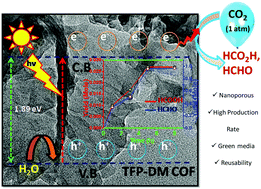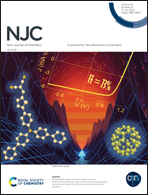A nanoporous covalent organic framework for the green-reduction of CO2 under visible light in water†
Abstract
Herein, we designed a sheet-like nanoporous covalent organic framework (TFP-DM COF) based nanomaterial, which was formed via an easy solvothermal synthetic method. The as-synthesized material was characterized via FTIR spectroscopy, PXRD, UV-Vis, N2 adsorption–desorption studies, TEM and FESEM techniques. We demonstrated the photocatalytic reduction of CO2 into HCOOH and HCHO using the as-synthesized COF as the active photocatalyst and water as a green solvent as well as sacrificial electron source under atmospheric pressure. It was observed that the formaldehyde production rate was 36-fold higher than the formic acid production rate under white LED light irradiation. The catalyst showed good yields for both the products, HCOOH (0.019 mole) and HCHO (0.47 mole), even under sunlight irradiation. In addition, the COF material exhibited sufficient reusability without noticeable catalyst deactivation, which suggested the material to be a promising heterogeneous photocatalyst for commercial use in the CO2 reduction reaction under green reaction conditions.



 Please wait while we load your content...
Please wait while we load your content...